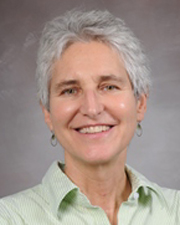Biography
Dr. Kaplan grew up in Center City Philadelphia where she attended public school. She received her B.A. in Biology from Brandeis University outside of Boston. She worked for two years as a research assistant at the Woods Hole Oceanographic Institute before joining E. Peter Greenberg’s lab at Cornell University.
Dr. Kaplan received her PhD in Microbiology as Pete Greenberg’s first graduate student to study Vibrio fisheri autoinduction, which later became known as quorum signaling. After completing her postdoctoral fellowship at Stanford University with Dale Kaiser studying Myxococcus xanthus development, she started her own lab at UTHealth Houston’s McGovern Medical School, where she is also an associate professor.
Dr. Kaplan is married and has two college-aged sons. She enjoys running and sailing and various volunteer activities.
Education
- Postdoctoral Fellow
- Stanford University
- Ph.D.
- Cornell University, 1986
Areas of Interest
Research Interests
Cell-cell interactions required for multicellular development and biofilm formation
The complex behavioral responses of bacterial communities to their changing environment is my research focus. I have a special interest in the cell-cell communication and transduction of quorum signaling and have focused primarily on surface-associated single- and multi-species bacterial communities, termed biofilms. Specifically, we examine the physiology, interactions, and dynamics that orchestrate the development programs, which control the initiation and dissolution of a variety of model biofilms, including surface gliding motility and fruiting body formation of the Gram-negative bacterium, Myxococcus xanthus.
Our laboratory has extensive collaboration in the Texas Medical Center. Interactions with my former shared graduate student and now colleague at the University of Texas School of Public Health, Dr. Charles Darkoh, have expanded our research into pathogenesis through studies of quorum signaling control of Clostridium difficile toxin synthesis. This work has been particularly exciting and rewarding, as our discoveries have resulted in two patents that will make major contributions to the diagnosis and treatment of this critically important multidrug-resistant pathogen that considered by the CDC to be the number one emerging pathogen.
We have also recently developed in vitro and ex vivo multispecies anaerobic oral biofilms models of dental caries and a single-species Enterococcus faecalis model for osteomyelitis bone infections. All of these projects use a combination of molecular, genetic, biochemical, and cell biological techniques to identify and characterize the components of the signaling pathways that control these important bacterial development and pathogenic model systems.
Publications
Darkoh, C., DuPont, H., and H.B. Kaplan. Novel one-step method for detection and isolation of active-toxin-producing Clostridium difficile strains directly from stool samples. J. Clin. Microbiol. 49:4219-4224, 2011.
Tribble, G.D., Rigney, T., Dao, D-H., Wong, C., Kerr, J., Taylor, B., Pacha, S. and H.B. Kaplan. Natural competence is a major mechanism for horizontal DNA transfer in the oral pathogen Porphyromonas gingivalis. Mbio. 3: e00231, 2012.
De Paula, R.M., Keasler, V., Bennett, B., Keller, C., Adams, R., Valkman, Z., and H.B. Kaplan. “Optimization of a microbial control program in an aging Gulf of Mexico asset to minimize the risk of corrosion,” NACE Corrosion 2012, Salt Lake City, UT (Houston, TX: NACE, 2012), p.1195-1208.
Zhang, Y., Vaksman, Z., Litwin, D.B., Shi, P., Kaplan, H.B. and O. Igoshin. The mechanism and physiological role of Myxococcus xanthus predatory rippling behavior. PLoS Comput. Biol. 8:e1002715, 2012.
Ambrose, C.G., Clyburn, T.A., Mika, J., Gogola, G.R., Kaplan, H.B., Wanger, A., and A. G. Mikos, Evaluation of antibiotic-impregnated microspheres for the prevention of implant-associated orthopaedic infections. J Bone Joint Surg. Am. 96:128-134, 2014.
